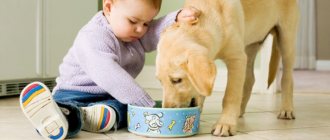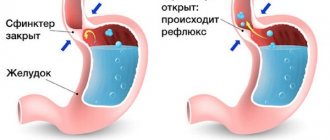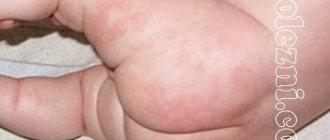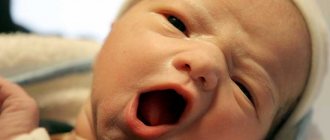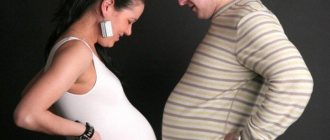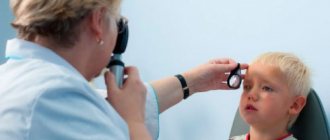- What role does intestinal microflora play for a child’s body?
- Which bacteria are classified as “beneficial”?
- Why dysbiosis occurs: the main causes in children
- How dysbiosis manifests itself in children: clinical symptoms
- Methods for diagnosing dysbiosis in children
- Treatment of dysbiosis in children
- Prognosis and prevention
The term “germs” does not always mean disease and danger, although many people associate it with trouble. Meanwhile, microbes can be pathogenic, which really pose a threat to health, and beneficial, which help create and strengthen the immune system and take an active part in the process of digesting food. Beneficial microbes live in the intestines, their main function is to suppress the growth and vital activity of pathogenic flora - as soon as the balance of beneficial and pathogenic microorganisms is disturbed, the disease dysbiosis occurs. Dysbacteriosis most often occurs in children, since the immune system is not yet fully formed and under the influence of various unfavorable factors, pathogenic microorganisms can defeat beneficial flora.
What role does intestinal microflora play for a child’s body?
Beneficial intestinal bacteria not only maintain balance and build immunity, they also play a huge role in other important processes occurring in the body of children:
- produce enzymes and hormone-like active substances, with the help of which the process of food digestion is improved;
- promote the body's absorption of vital microelements (copper, iron, potassium, calcium, sodium, magnesium) and vitamin D;
- participate in the production of vitamins K, B1, B2, B9, B5, B6, B12;
- protect the child’s body from dangerous infectious pathogens (salmonella, fungi, dysentery bacillus) - when these pathogens are ingested with food, beneficial intestinal bacteria produce substances that block the processes of growth and reproduction of pathogenic flora;
- promote intestinal motility and fecal formation;
- neutralize the effect of salts of heavy metals, nitrates, chemical harmful substances, toxins - bind them and remove them from the intestines naturally.
Which bacteria are classified as “beneficial”?
The intestinal microflora of a healthy child consists of the following bacteria:
- bifidobacteria - about 90%, they are the most important;
- lactobacilli – about 8%, produce lactic acid and help maintain optimal pH levels;
- opportunistic microorganisms - that is, those that are found in the intestines in small quantities and do not threaten health in any way until a certain point. When a child becomes ill, takes antibiotics, is poisoned, or has a digestive disorder, the opportunistic flora is activated, begins to multiply rapidly, and thereby suppresses the number of lacto and bifidobacteria. In this case, all the symptoms of intestinal dysbiosis occur. Conditionally pathogenic flora includes yeast-like fungi, staphylococci, Escherichia coli Klebsiella, and enterobacteria.
From the latter we can judge that dysbiosis in children is not a separate disease, but only a consequence of the pathological processes that have occurred in the body, the occurrence of which is facilitated by many factors and causes.
Symptoms and signs of intestinal dysbiosis in children
Symptoms of dysbiosis in children differ depending on age. Newborn and infant babies cannot explain deviations in the digestive system.
The development of a pathological process in this case may be indicated by frequent crying of the child, excessive passage of gases, bloating and too frequent bowel movements (up to fifteen times a day, undigested food particles or foam are present in the stool). In older children, symptoms appear with additional manifestations.
The main symptoms of dysbiosis:
- pain in the abdomen (intensifies in the afternoon);
- excessive irritability and sleep disturbance;
- lactose intolerance (comorbidity);
- manifestation of flatulence and rumbling in the stomach;
- alternating diarrhea with constipation;
- pain in the digestive organs after eating food;
- weight gain at a slow pace;
- allergic manifestations (skin reactions);
- green stool with mucus (in newborns);
- bad breath;
- presence of a metallic taste in the mouth;
- tendency to frequent colds.
Why dysbiosis occurs: the main causes in children
While the baby is in the womb, its intestines are sterile and only after birth it begins to be populated by microflora. That is why it is extremely important to lay the “foundation” in the form of strong immunity to attach the newborn to the mother’s breast in the first 2 hours. Mother's colostrum contains a huge amount of lacto and bifidobacteria, antibodies, vitamins and microelements that contribute to the formation of normal intestinal microflora and the health of the child. Among the causes of dysbiosis in children in the infant period (from birth to one year) the following are distinguished:
- late breastfeeding (later than 2-3 hours after birth) - this can happen in the case of a difficult birth, severe condition of the mother or baby;
- administration of antibiotics to the mother or child;
- improper nutrition of a nursing mother - the predominance in her diet of potential allergens and products that increase gas formation in the intestines;
- artificial or mixed feeding;
- early introduction of the first complementary foods to the child;
- previous intestinal infections or food poisoning;
- frequent changes of adapted milk formulas for a formula-fed child - if you feed your baby with milk formula and it is completely suitable for him, you cannot change the diet at will or in order to save money;
- atopic dermatitis in a child.
In children over 1 year old, the most common causes of dysbacteriosis are:
- unbalanced diet - predominance of flour products, baked goods, pasta, dairy products, abuse of sweets;
- chronic diseases of the gastrointestinal tract - dyspepsia, gastritis, bending of the gallbladder;
- frequent colds and weak immunity;
- abuse of antibiotics and other drugs without a doctor’s prescription;
- allergic diseases;
- helminthic infestations;
- hormonal disorders - they often occur while taking hormonal medications or during the child’s puberty, as well as against the background of diseases of the glands that produce hormones (thyroid, pancreas, pituitary gland);
- previous operations on the organs of the digestive system;
- stress and unfavorable psychological environment.
How dysbiosis manifests itself in children: clinical symptoms
In children of the first year of life, symptoms of dysbiosis are expressed in the following signs:
- rumbling in the stomach;
- bloating and discharge of gases;
- crying due to pain and discomfort in the abdomen;
- frequent and profuse regurgitation “fountain”;
- attacks of intestinal colic, worsening in the evening and at night;
- frequent loose stools with abundant foam and lumps of undigested milk - up to 15 times a day.
In children over 1 year of age, the following predominate symptoms of intestinal dysbiosis:
- diarrhea and constipation - the stool contains not digested food particles, but the stool itself with a pronounced unpleasant odor;
- rumbling in the stomach;
- bloating and flatulence;
- abdominal pain after eating;
- frequent viral infections and weak immunity;
- lactose intolerance in most cases;
- allergic skin rashes.
A child with intestinal dysbiosis may experience rapid weight loss or poor weight gain, which is associated with disturbances in the processes of food digestion, as a result of which the body does not have time to absorb nutrients from incoming food.
Due to constant abdominal pain and disruption of the process of digesting food, the child may become capricious, whiny, and have difficulty sleeping at night.
Types of dysbacteriosis
Symptoms of dysbiosis do not manifest themselves in the same way in all children, since the condition has its own types. So, doctors identify the following types of dysbiosis:
- Compensated dysbiosis - with this type of disorder, external signs cannot be seen. The child will be cheerful, cheerful, his tummy does not hurt, there is no flatulence and his appetite does not suffer. The stool may have normal consistency and there is no constipation or diarrhea. This condition is discovered by chance if there is a need to take a stool test for another reason.
- Uncompensated - the condition has pronounced symptoms, which most often frighten young parents, forcing them to talk about dysbiosis as a pathology. Indeed, the child develops the following disorders:
- loose stools mixed with mucus, unpleasant odor, bubbles, and remnants of undigested food;
- sometimes constipation;
- bloating;
- regurgitation;
- skin rashes;
- coating on the tongue;
- loss of appetite;
- lethargy and weight loss.
It is these symptoms that make parents sound the alarm and consult a doctor. And this is correct, because some diseases of the gastrointestinal tract manifest themselves in the same way as dysbiosis manifests itself. Therefore, it is necessary to undergo tests and conduct competent differential diagnostics. After all, even a rash due to dysbacteriosis in a baby in the absence of other symptoms can signal a microflora disorder.
Methods for diagnosing dysbiosis in children
As a rule, the doctor can assume that the child has intestinal dysbiosis based on the mother’s complaints. To confirm the diagnosis and exclude or identify concomitant diseases of the gastrointestinal tract, the patient is prescribed additional studies:
- bacteriological examination of feces - this analysis allows you to determine which bacteria predominate in the intestines, calculate their number and select an effective medicine in relation to pathogenic pathogens;
- feces for coprogram - a study that allows you to evaluate the process of digestion of food in the intestines;
- Ultrasound of the gastrointestinal tract - allows you to identify disturbances in the functioning of the digestive organs, determine functional changes and congenital structural anomalies that prevent food from being fully absorbed.
If necessary, a specialist may recommend a consultation with a pediatric gastroenterologist, as well as prescribe an FGDS or other diagnostic methods.
Treatment of dysbiosis in children
Treatment of dysbiosis must be comprehensive and include not only symptomatic therapy, but also methods aimed at eliminating the main problem that provoked the imbalance of bacteria in the child’s intestines. Typically, treatment includes:
- diet;
- medications;
- symptomatic therapy.
Diet for dysbiosis
In the treatment of dysbiosis, diet plays a huge role, sometimes even more than drug therapy.
For children of the first year of life, breast milk is recommended, since natural feeding has a beneficial effect on the intestinal microflora. For artificial babies, it is important to choose the right adapted milk formula and not change it if this food suits the child. Frequently changing milk formulas for the sake of economy or just for fun can lead to serious digestive disorders in infants and cause dysbiosis and other problems.
Children over 1 year old who already eat from the common table are recommended to include fermented milk products in their diet:
- cottage cheese (fat content is no more than 5%);
- fermented baked milk;
- curdled milk;
- sour cream;
- kefir;
- natural yogurt without sugar.
The diet should limit sugar, baked goods, fried and fatty foods, chocolate, sweets, and cookies. Pork, sausages, spices, and smoked products are completely excluded - these products not only disrupt the digestion process, but are generally harmful to the child’s body.
It is better to give vegetables to children over 1 year of age in boiled and grated form, so they do not irritate the intestines and promote gentle cleansing. It is recommended to temporarily exclude fresh fruits (especially sour ones); you can give your baby bananas in small quantities.
If correcting the child’s diet is not enough to eliminate signs of dysbiosis, then the doctor will additionally prescribe medications.
Drug treatment of dysbiosis
The main goal of drug treatment is:
- destruction or suppression of pathogenic intestinal microflora - for this purpose, antibiotics are prescribed, if necessary, bacteriophages and probiotics;
- carrying out replacement therapy - the intestinal microflora is populated with beneficial lactic bacteria.
Important! An antibiotic is prescribed to children only if dysbiosis is caused by infectious diseases of the gastrointestinal tract, which is confirmed by clinical tests. Self-medication with drugs of this group is unacceptable, as it can worsen the symptoms and course of the disease.
Bacteriophages are a “therapeutic” virus that is injected into a child when a certain type of pathogen is detected, for example, dysentery bacillus or salmonella. This virus is capable of destroying the infectious agent without the additional use of antibiotics. Of course, such drugs are prescribed by a doctor and only after studying the test results.
The most basic, safe and widely used drugs for the treatment of dysbiosis and correction of intestinal microflora are probiotics. They are available in the form of enteric capsules, drops, powders for preparing a solution and its further oral use. This group of drugs includes:
- Bifi-form - a drug containing lacto and bifidobacteria, as well as B vitamins, can be prescribed to children from the first days of life;
- Acipol – this drug contains lactobacilli and kefir fungus, can be used for the treatment and prevention of dysbiosis in children from the first days of life;
- Linex – the drug contains lacto and bifidobacteria, as well as substances that help improve digestion and absorption of beneficial microelements from food, can be used from the first days of a child’s life;
- Bifidumbacterin is a drug that suppresses the growth and activity of opportunistic intestinal flora and creates conditions for beneficial lactobacilli for enhanced growth and reproduction.
Separately, it should be said about the drug Enterol. It not only populates the intestines with lacto and bifidobacteria, but also contains yeast, which increases the drug’s resistance to antibiotics.
Symptomatic treatment of dysbiosis
Since if the balance of beneficial and opportunistic bacteria is disturbed in a child, the digestion process and stool are disrupted, the following drugs are additionally prescribed as symptomatic therapy:
- sorbents – help bind toxins and heavy metal salts from the intestines, reduce signs of intoxication in the body. Drugs in this group are especially relevant if intestinal dysbiosis in a child is caused by food poisoning and prolonged diarrhea or taking antibiotics;
- enzymes - to improve the digestion of food, as well as reduce signs of bloating and rumbling in the stomach, the child is prescribed a certain dose of enzymes. The drug should be given to the baby during meals.
When does dysbiosis occur in a baby and what is it?
The human body contains both sterile and non-sterile environments. For example, blood is sterile, but the intestines can rightfully be called a non-sterile environment. However, a newborn’s intestines are also sterile, but already in the first days of the baby’s life, bacteria begin to populate it.
Most bacteria are friendly to the body - for example, in the intestines, more than three hundred different microorganisms can simultaneously exist. The main ones are:
- bifidobacteria;
- lactobacilli;
- enterococci;
- streptococci.
They do not conflict with each other only because they are contained in a certain ratio - balance. When bacteria just begin to enter the intestines, they cannot yet balance in the environment. Therefore, during the first year of a baby’s life there is a “struggle for a place in the sun” between various microorganisms. Thus, dysbiosis in infants is an imbalance of beneficial and harmful microorganisms when colonizing the intestines.
Doctors point out that it is impossible to unify the set of microflora - it is different for each child and there is no list with the permissible number of certain microorganisms. In most cases, the composition of bacteria will resemble mom and dad's set.
Important! Today, doctors practice keeping a child and his parents together as early as possible so that there is an exchange of protective microorganisms necessary for the normal functioning of the child’s body.
Prognosis and prevention
If the child follows the doctor’s recommendations and a certain diet, dysbiosis can be cured in 1 month, but if there are concomitant chronic gastrointestinal diseases, it may take a little longer. In the future, to prevent the development of dysbiosis, you should follow simple rules:
- do not take antibiotics without a doctor’s prescription;
- do not abuse laxatives - if a child has problems with bowel movements, then it is better to review his diet and include more fiber and water. If nutritional correction is not effective, then to improve bowel movements, the child is given lactulose-based drugs in an age-appropriate dosage.
Dysbacteriosis is not uncommon among young children, so parents should closely monitor the baby’s health and not ignore symptoms of digestive dysfunction. If the problem is left unattended, the progressive growth of opportunistic flora quickly leads to the development of various intestinal diseases and weak immunity in the child.
Treatment
Therapy begins with a strict diet. Then replacement therapy is added to ensure normal digestion and stimulate the growth of its own beneficial microflora. Symptomatic therapy is also prescribed, which usually worries parents the most.
Diet
The basics of diet therapy depend primarily on the age of the child. The basic principles are based on the prohibition and recommendation of certain products:
| Recommended Products | Not Recommended Products |
|
|
Up to 1 year
When artificial feeding, it is necessary to change the formula. Fermented milk mixtures containing many beneficial bacteria are recommended.
When breastfeeding, it is necessary to completely switch the baby to breast milk, and the mother to be put on a strict diet that corresponds to the permitted and prohibited foods presented earlier in the table.
From 1 year to 3 years
At a young age, when the child is already feeding on his own, without formula or mother’s breasts, it is necessary to limit his diet to the same products that are provided in the table.
All food must be thermally processed. It is necessary to strictly count calories, since any energy deficiency negatively affects the growing body of the child. The diet should have enough all minerals and vitamins.
Children over 3 years old
The principle of nutrition for children over three years of age corresponds to the data presented in the table, with the exception of some products.
Thus, to correct vitamin deficiency, fresh fruits are recommended for older children: bananas, apples (they should not be red, they prefer the Semerenko variety, lemon). It is necessary to exclude possible allergens: chocolate, nuts, red fruits (strawberries, raspberries, cherries, etc.), tomatoes, honey, citrus fruits.
Be sure to read:
Why and what causes my stomach to growl, what to do?
To stimulate the growth of beneficial microflora, prebiotic products containing fiber are needed: various types of cabbage (broccoli, cabbage, cauliflower, Peking cabbage and others), legumes, bran and others.
Drugs
The main medications approved in childhood for dysbiosis include:
- Bifidumbacterin. It is recommended to use it in the form of a lyophilisate, which is calculated by dose. One bottle contains 5 doses. The drug is approved for use from 0 years.
- Bifiform baby. A special probiotic composition for little ones is available in a convenient form of solution for oral administration. Approved for use by children from the first days of life.
- Acipol. A combined preparation of live beneficial bacteria and kefir proteins, which has a beneficial effect on the growth of natural microflora and supports normal digestion.
- Lactofiltrum. Recommended for high levels of pathogenic microorganisms based on culture results for dysbiosis. Allows you to preserve beneficial microbes while destroying opportunistic and pathogenic ones.
- BioGaia. In newborns, along with the probiotic effect, it can effectively eliminate colic and flatulence.
Dysbacteriosis can be cured at home only if all the doctor's prescriptions are followed. Self-treatment, without laboratory control, can lead to chronicity of the process and deterioration of the baby’s condition.
